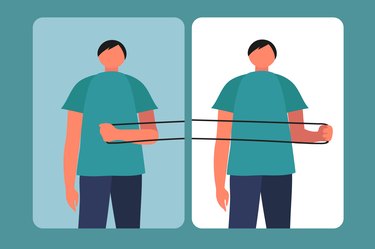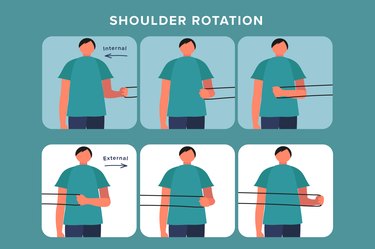


Your typical shoulder workout may be full of overhead presses and lateral raises. But banded internal and external shoulder rotations are one underrated exercise dup you don't want to leave out of your training routine.
- What are shoulder rotations? They're exercises that involve closing and opening your shoulder towards and away from your body.
- What's the difference between internal and external rotations? Shoulder internal rotation exercises involve turning your shoulder toward your body, according to Carolina Araujo, CPT, a California-based personal trainer and founder of Fit With Carolina. External rotation of the shoulder turns the joint away from your body.
- What muscles do these exercises work? Internal shoulder rotations strengthen your front deltoids, latissimus dorsi, pectoralis major, teres major in your back and subscapularis, one of the four rotator cuff muscles, according to Araujo. External shoulder rotations strengthen your rear delts as well as infraspinatus, and teres minor, two other rotator cuff muscles that stabilize your shoulder blades.
- Who can do shoulder rotations? They are a pretty safe exercise for most people and are a common rehab exercise for shoulder injuries, according to Melissa Garcia, DPT, CSCS, a Washington-based physical therapist. But anyone who has previous shoulder injuries (or feels pain or pinching) should talk to a qualified physical therapist before trying new exercises.
Video of the Day
How to Do Banded Internal and External Shoulder Rotations

Move 1: Internal Shoulder Rotation
- Attach a resistance band to a sturdy object at torso height. Stand so that it's on your left.
- Grasp the free end of the band with your left hand and take several steps away from the anchor point until the band is taught.
- Stand tall with your left elbow bent to 90 degrees and pressed against your side with a small rolled towel between your elbow and body.
- Starting with your forearm out to your side, pull the band toward the center of your body while keeping your elbow tight to your side.
- Pause, then slowly return to the band to your side.
- Do all reps, then switch sides.
Tip
For all external and internal rotations, place and hold a small, rolled-up towel (a t-shirt works, too) between your elbow and body. The added padding can help reduce stress on your joints, which is especially helpful for those recovering from an injury.
Move 2: External Shoulder Rotation
- Attach a resistance band to a sturdy object at torso height. Stand so that it's on your right.
- Grasp the free end of the band with your left hand and take several steps away from the anchor point until the band is taught. The band should cross in front of your body.
- Stand tall with your left elbow bent to 90 degrees and pressed against your side with a rolled towel between your elbow and body.
- Starting with your forearm diagonally across your body, pull the band away from the anchor to your side while keeping your elbow tight to your side.
- Pause, then slowly return to the band in front of you.
- Do all reps, then switch sides.
Use These Best Resistance Bands
- SUNPOW Pull Up Assistance Bands ($19.99, Amazon.com)
- TheraBand ($16.12, Amazon.com)
- Weluvfit Long Resistance Bands ($13.59, Amazon.com)
4 Shoulder Rotation Exercise Tips
1. Keep Your Elbows Still
When your elbow moves away from your side, you start to lose out on some of the intended exercise benefits, Garcia says.
To help you keep that elbow tucked, she suggests placing a rolled-up towel between your elbow and ribs. Focus on keeping it in place throughout the entire exercise.
As you work to not let the towel fall, you'll automatically improve your form.
2. Use Light Resistance
Because these exercises focus on so many small stabilizing muscles of the shoulder, don't expect yourself to move a lot of (banded) weight, says Jereme Schumacher, DPT, a California-based physical therapist.
If you struggle to do 8 or 10 reps with good form, use a lighter resistance or stand closer to the band's anchor point. These are exercises you shouldn't usually load any heavier than your 8 or 10 rep max.
3. Move With Control
Keep the motion as precise as possible, Schumacher recommends. Don't let the band boss you around, and resist the urge to swing your arm or use momentum.
If you have trouble keeping a slow, steady pace, try counting: 2 seconds moving, a 1-second pause, then 2 seconds back to start.
4. Brace Your Core
Keep your abs tight with your hips and shoulders squared to the front of the room, Garcia says. Avoid twisting your torso as you pull the resistance band, and keep your lower back from arching.
Fun tip: Squeezing your glutes will actually help you max out your stability in the move.
4 Shoulder Rotation Exercise Benefits
1. They Help Reduce the Risk of Shoulder Injury
Although they're surrounded by small stabilizing muscles, your shoulders are actually the least stable joints in your body, according to the American Academy of Orthopaedic Surgeons (AAOS). And when their muscles don't get enough attention, your joints become even more susceptible to injury.
That's why Schumacher recommends building internal and external rotations into your warm-up routine. Waking up your small stabilizers before upper-body workouts can help you keep your shoulders stable and safe through the rest of your workout, he says.
2. They Improve Workout Performance
Warm shoulders aren't just safer, they're stronger. These exercises improve your upper-back and shoulder alignment, which can help you move more weight in exercises like deadlifts and walking lunges, Garcia says.
3. They Build Shoulder Strength and Muscle
Internal and external rotations of the shoulder make great warm-up exercises, but the moves can also stand on their own in a strength workout. You can can do the shoulder external rotation with a dumbbell to get more precise with how much resistance you're using and track your progress.
And making them among the best shoulder exercises, rotations hit the rotator cuff muscles, which often go neglected, Garcia says.
To build the most strength and muscle, focus on taking each set to fatigue. At the end of your set, you should feel like that was the last rep you could do with great form.
4. You Can Tailor Them to All Strength Levels
To make this resistance-band shoulder exercise more or less challenging, all you have to do is stand farther from or closer to the band's anchor point.
Or, if you have a set of multiple bands, you can simply pick one with greater or lighter resistance.
3 Shoulder Rotation Variations
Move 1: Banded External Walkout
- Attach a resistance band to a sturdy object at torso height. Stand so that it's on your right.
- Grasp the free end of the band with your left hand. The band should cross your in front of your body.
- Stand tall with your left elbow bent to 90 degrees and pressed against your side. Place a rolled-up towel between your elbow and ribs if needed. Hold this position.
- Take several steps to your left until the band is at full resistance.
- Reverse the motion.
- Do all reps, then switch sides.
Move 2: Banded Internal Walkout
- Attach a resistance band to a sturdy object at torso height. Stand so that it's on your right.
- Grasp the free end of the band with your right hand.
- Stand tall with your right elbow bent to 90 degrees and pressed against your side. Place a rolled-up towel between your elbow and ribs. Hold this position.
- Take several steps to your left until the band is at full resistance.
- Reverse the motion.
- Do all reps, then switch sides.
Move 3: Dumbbell Side-Lying Shoulder External Rotation
- Lie on your left side with your knees stacked and bent at a 90-degree angle.
- Hold a light dumbbell in your right hand, parallel to the floor.
- Place a towel between your right arm and right side. Keep your elbow snug against your right side, bent at 90 degrees.
- Draw the dumbbell up toward the ceiling, keeping your elbow stable.
- Reverse the motion and return to the starting position.
- Do all reps, then switch sides.
Was this article helpful?
150 Characters Max
0/150
Thank you for sharing!
Thank you for your feedback!